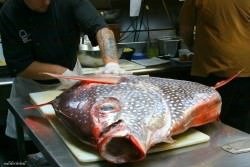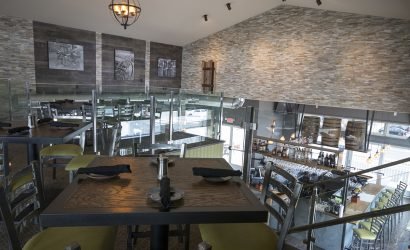The restaurant industry is undoubtedly, changing. Instead of simply presenting menu selections, establishments are increasingly informing diners of where the featured foods come from. In this way, the restaurants are supporting local farmers and fishermen and simultaneously taking the guesswork out of how fresh the food is, or how far its traveled. Leading the charge of promoting the use of fresh, sustainable, often organic, local food sources in the Ocean City area is Travis Wright’s The Shark on the Harbor restaurant, located in the Commercial Fishing Harbor in West Ocean City.
The fish and shellfish on the menu at The Shark literally come fresh off the boats; the unloading process called “packing out” visable from the restaurant windows. The fish, in their whole form, are then wheeled up the ramp from the docks into The Shark where they will be turned into any number of creative dishes. The Shark changes their menu daily, based upon what produce they receive from area farmers, and what fish comes in off the boats. There’s no question as to where this food comes from. Want to know more about how fresh dinner at The Shark truly is? Follow the story of one fish in particular, as it was caught by chance by the Captain of the Sea Born, and ended up on the table at The Shark, below…
On any given day, the docks in West Ocean City’s commercial fishing harbor are bustling with boats packing out—the process when the vessel is unloaded, the fish are weighed and graded, placed on ice, and readied for their next destination. On one of these typical days, a small crowd was gathered around the crew of the Sea Born. There was a palatable air of excitement circulating. Placed on a slab behind Captain Kerry Harrington, waiting its turn to be weighed was a large round brightly colored fish that clearly didn’t look as if it belonged in the waters of the Mid-Atlantic.
The talk on the docks sounded like those “fish stories;” tall tales recounted by fishermen, who never had any proof of what they supposedly caught or wrestled with. Yet here was the proof, all 109 pounds of it. Stories ranged from a private boat owner who swears to have rescued a fish like this from a shark in the Caribbean, and then ate it for dinner himself—to the honest account of Captain Kerry hooking this one accidentally, while fishing long line for tuna. It was his first in 35 years at sea. Three things were agreed upon by consensus—the fish was an Opah, it was extremely rare in the waters of the Mid-Atlantic, and it was likely destined to be on the menu at The Shark on the Harbor.
The Opah’s chance meeting with the Sea Born’s line did indeed land it on The Shark’s dinner menu, making the Opah the epitome of what eating fresh truly means. For Travis Wright, chef/proprietor of The Shark on the Harbor in West Ocean City, this process of preparing whatever is brought in fresh off the boat, is business as usual. That’s not to say that the Opah didn’t bring a huge amount of excitement—it is likely the first time a whole Opah was caught off the coast of Ocean City, brought into the harbor, and prepared by a local restaurant—which is undeniably a magnificent culinary coup. But preparing what’s caught each week is simply how the restaurant works.
The Shark moved to its present location in the harbor in 2008. Downsizing from a larger restaurant gave Travis, wife Jody, and Chef de Cuisine Nate Britko the opportunity to focus on using quality ingredients that were fresh, local, and organic. On the menu daily are three different $5.99 lunch specials, at least one soup special, an appetizer special and at least two dinner specials that are created entirely based upon what the local fishermen are catching, as well as what the local farms are producing. In the words of Travis Wright, “We let the ingredients steer the ship in that regard,” and that pun was intended.
This approach makes for a seasonal menu using the freshest local ingredients available. Many local vendors including Quindocqua Farms and Chesterfield Heirlooms furnish The Shark with produce; Chesapeake Bay Farms in Berlin provides cheese, ice cream, and all-natural beef, and SB Farms in Hurlock supplies all-natural bison. The from-the-sea fare is caught by a number of local fishermen. Merrill Campbell of the Southern Connection Dock contributes local black bass, cod, flounder, lobsters and scallops. Capt. John from the Pot Luck also supplies lobsters. Chief amongst this local crew has to be Kerry Harrington, who typically brings in Mahi-Mahi, swordfish, tuna and Mako. He often drops a special set of lines for golden tilefish, just for The Shark. Captain Kerry is known to favor The Shark for the special catches, because he knows there’s an appreciation.
It’s obvious that a relationship has been fostered here, so much so that when Captain Kerry caught his first ever Opah, he sent a satellite email to Travis Wright, (the only method of communication when the Sea Born is out). Wright, and his staff—Chef Nate Britko, Chef Brook Lamar – known affectionately combined as the “three headed monster,” and Cousin Jimbo, who has the distinction of being the only member of this heralded culinary team who actually went to culinary school, began conspiring on how to prepare the Opah.
The Opah is much more common in Hawaii, but the fish don’t travel in schools, making them inconvenient fare for commercial fishermen; the Opah are often then “gifted” away by the fishermen to local restaurants, and they are considered revered. The Shark chose to honor the fish with the preferred method of preparation, Huli Huli Bar-B-Que style, accompanied by sesame grilled green tomatoes, and Thai purple rice.
Keeping in mind the “fresh” concept below is the time line of events, following the Opah from the deck of the Sea Born to the tables at The Shark.
Tuesday: The Opah is caught and hauled onto the decks of the Sea Born; Kerry sends an email to Travis with the good news.
Wednesday night: the Sea Born docks
Thursday mid-day: it’s the Sea Born’s turn to pack out. The Opah makes its debut around 1pm, weighing in a 109 pounds. It’s packed on ice, bound for The Shark, just across the harbor.
Friday 1pm: The Opah is carted up the restaurant’s ramp and into the kitchen, in front of a crowd of curious patrons.
Friday afternoon: Chef Brook Lamar spends the next hour and a half cutting the fish into at least 40 steaks.
Friday at 5 p.m.: The Opah is dressed for dinner, Huli Huli Bar-B-Que style. It sells out, and receives rave reviews; diners liken it to a swordfish or escolar in texture with a sweeter and milder taste. The kitchen for experimental purposes, intentionally reserves a few pieces.
By the following Tuesday, the few remaining pieces of Opah have again found themselves on the menu, this time as Opah bacon and Opah dip. It’s just one week out from being caught, and that’s all that remains. What chefs Travis, Nate, and Brook have really accomplished with The Shark, is to embrace the old way of doing things, and in so they’ve spearheaded a return to the healthy eating of whole foods, and supported local producers in the process. Beyond the glitz and glamour of Ocean City, exists the blue-collar world of fishing and agriculture, and it’s always been there. Before there were ever broadline companies that supplied provisions, there were local merchants who provided food direct to the area restaurants. The Shark is the embodiment of the modern day food renaissance—the farm and ocean to table mentality, but they take it one step further, and put a creative spin on each unexpected dish, truly make food into art.
View the ever-changing daily lunch and dinner menus, and find out more about The Shark on the Harbor.
Follow the pictorial story of the Opah below, from the waters of the Mid-Atlantic to the tables at The Shark. Photo by Natalee DeHart.








